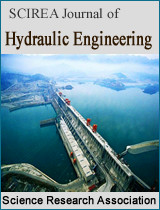Investigation of water hammer in bending stainless steel pipe under gravity flow
DOI: 10.54647/hydraulic57030 61 Downloads 6096 Views
Author(s)
Abstract
A water hammer experimental setup consisting of a 20m long pipe having 8 U-shaped 180¬0 bends is investigated for hydraulic transient. Experimental results are then compared to numerical results simulated by the Method of Characteristics (MOC) and the Wave Characteristic Method (WCM). It is found that one-phase flow one-dimensional models of these numerical schemes are not robust enough to accurately predict the transient phenomenon taking place in such complex pipelines as in the experiment. The two-phase flow one-dimensional models: The Discrete Vapor Cavity Model (DVCM) and Discrete Gas Cavity Model (DGCM), coupled with Vardy & Brown’s unsteady friction model obtained more accurate numerical results considering the frequency and magnitude of the peak and minimum pressures of the characteristic curve. Also, these numerical results confirmed the impact of the presence of voids and gases on the wave speed as the reduction of the constant wave speed from 1000m/s in one-phase flow to 700m/s in two-phase accurately simulated the transient phenomenon in the experimental setup.
Keywords
Hydraulic transient, two-phase flow, cavitation, U-shaped bend, Pressure characteristic curve, DVCM, DGCM, WCM
Cite this paper
Yujian Ping, Akoto Emmanuel, Huli Ren,
Investigation of water hammer in bending stainless steel pipe under gravity flow
, SCIREA Journal of Hydraulic Engineering .
Volume 5, Issue 1, February 2022 | PP. 1-18.
10.54647/hydraulic57030
References
| [ 1 ] | C. C. Bonin, Water Hammer Damage to Oigawa Power Station, Journal of Engineering for power, 82(2),111-116, 1960. https://doi.org/10.1115/1.3672721. |
| [ 2 ] | Wylie B. E., Streeter V. L., Suo L., Fluid Transients in Systems, Englewood Hills New Jersey, Prentice Hall, 1993. |
| [ 3 ] | Joukowsky, N., “Über den hydraulischen Stoss in Wasserleitungsröhren.” (“On the hydraulic hammer in water supply pipes.”) Mémoires de l'Académie Impériale des Sciences de St.-Pétersbourg Series 8, 9(5), 1-71, 1900. (in German). |
| [ 4 ] | Streeter V. L., Wylie B. E., Bedford K. W., Fluid Mechanics, WCB McGraw-Hill, New York, 1998. |
| [ 5 ] | Ramos H., de Almeida B. A., Parametric Analysis of Water Hammer Effects in Small Hydro Schemes, Journal of Hydraulic Engineering, 128 (7), pp. 689–696, 2002. |
| [ 6 ] | Mitosek M., Fluid Mechanics in Environmental Engineering, WNT Warsaw, 2007. (in Polish). |
| [ 7 ] | Wood D. J., Jones S. E., Water-hammer charts for various types of valves, Journal of Hydraulic Division, 99(1), 167–178, 1973. |
| [ 8 ] | Thorley A. R. D., Fluid transients in pipeline system: a guide to the control and suppression of fluid transients in liquids in closed conduits, ASME Press, New York, 2004. |
| [ 9 ] | Marcinkiewicz J., Adamowski A., Lewandowski M., Flowmaster2TM and program using unsteady wall friction model to calculate water hammer loadings on pipelines, Nucl. Eng Des, 238, (8), 2084–2093, 2008. DOI: 10.1016/j.nucengdes. |
| [ 10 ] | Pires L. F. G., Laidea R. C. C., Baretto C. V., Transient Flow Analysis of Fast Valve Closure in Short Pipelines, Proceedings of International Pipeline Conference, Calgary, Alberta, Canada, 2004. |
| [ 11 ] | Kodura A., An Analysis of the Impact of Valve Closure Time on the Course of Water Hammer, Archives of Hydro-Engineering and Environmental Mechanics, Vol. 63, No. 1, pp. 35–45, 2016. DOI: 10.1515/heem-2016-0003. |
| [ 12 ] | Crane Co., Flow of Fluids Through Valves, Fittings, and Pipe, Technical Paper No. 410, Signal Hill CA, 2010. |
| [ 13 ] | Alexandre K. Soares, Nuno Martins, and Dídia I.C. Covas, Investigation of Transient Vaporous Cavitation: Experimental and Numerical Analyses, Procedia Engineering, 119:235-242, 2015. |
| [ 14 ] | A. Bergant, U. Karadzic, J. Vitkovsky, I. Vusanovic, and A. R. Simpson, A Discrete Gas-Cavity model that Considers the Friction Effects of Unsteady Pipe Flow, Journal of Mechanical Engineering, vol. 51, 2005. |
| [ 15 ] | Mohamed S. G., Ming Z., Duncan A. M., David H. A., A Review of Water Hammer Theory and Practice, Applied Mechanics Reviews, vol. 58, 49, 2005. DOI: 10.1115/1.1828050 |
| [ 16 ] | Susovan P., Prashanth R. H., Bryan W. K., An Overview of the Numerical Approaches to Water Hammer Modelling: The Ongoing Quest for Practical and Accurate Numerical Approaches, Water, 13, 1597, 2021. https://doi.org/10.3390/w13111597. |
| [ 17 ] | A. R. Simpsons and A. Bergant., Numerical comparison of pipe-column-separation models, Journal of Hydraulic Engineering, vol. 120, 1994. |
| [ 18 ] | A. E. Vardy and J. M. B. Brown, Transient turbulent friction in smooth pipe flows, Journal of sound and vibration, vol. 259:1011-1036, 2003. |
| [ 19 ] | Wood D. J., Dorsch R. G., Lightner C. (1965). Wave-Plan Analysis of Unsteady Flow. Journal of the Hydraulics Division, Proceedings of the American Society of Civil Engineers, 48, 1965, |
| [ 20 ] | P. G. Provenzano, F. Baroni, and R. J. Aguerre. The Closing Function in the Waterhammer Modeling. Latin American Applied Research, 2011. |
| [ 21 ] | Walters T., Marroquin A., Smith F., Understanding Water hammer in Pumping Systems – and Surge Suppression Options, Turbomachinery Laboratory, Texas A&M Engineering Experiment Station, TPS148 Rev 5, 2019. |
| [ 22 ] | Walters, T. W., and Leishear, R. A., 2018, “When the Joukowsky Equation Does Not Predict Maximum Water Hammer Pressures”, ASME PVP Conference, July 15-20, 2018, Prague, Czech Republic, ASME PVP2018-84338, 2018. |

